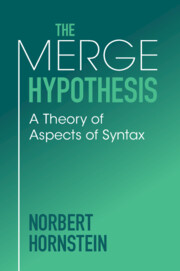Book contents
- The Merge Hypothesis
- The Merge Hypothesis
- Copyright page
- Contents
- Preface
- Abbreviations
- Introduction
- 1 A Whig History of Generative Grammar
- 2 Tools and Particulars
- 3 Adding Labels
- 4 Construal and the Extended Merge Hypothesis (1)
- 5 Construal and the Extended Merge Hypothesis (2)
- 6 A Partial Wrap-Up and Segue
- 7 Labels
- 8 Odds and Ends
- 9 Conclusion
- Bibliography
- Index
Introduction
Published online by Cambridge University Press: 15 February 2024
- The Merge Hypothesis
- The Merge Hypothesis
- Copyright page
- Contents
- Preface
- Abbreviations
- Introduction
- 1 A Whig History of Generative Grammar
- 2 Tools and Particulars
- 3 Adding Labels
- 4 Construal and the Extended Merge Hypothesis (1)
- 5 Construal and the Extended Merge Hypothesis (2)
- 6 A Partial Wrap-Up and Segue
- 7 Labels
- 8 Odds and Ends
- 9 Conclusion
- Bibliography
- Index
Summary
The book argues that the research program of modern Generative Grammar (GG) has been a resounding success. More particularly, it argues that the most current stage of this more general enterprise, the Minimalist Program (MP), has provided profound insights into the structure of the faculty of language (FL). The book outlines the central Minimalist thesis (the Merge Hypothesis) and suggests ways of extending its explanatory reach.
- Type
- Chapter
- Information
- The Merge HypothesisA Theory of Aspects of Syntax, pp. 1 - 12Publisher: Cambridge University PressPrint publication year: 2024

